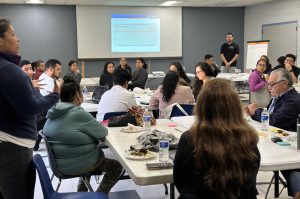
Advancing a Collaborative Agenda in Southeast LA
Advancing a Collaborative Agenda in Southeast LA In 2022, the California Community Foundation (CCF) launched the Regional Recovery Hub to strengthen place-based coordination in Los Angeles County
Variable Definitions:
Children in Single-Parent Households: The percentage of children under the age of 18 who live with only one parent
Families with Children: The percentage of households with a child under the age of 18 who is related to the head of household (by marriage, adoption or birth) living in the home
Living Alone: The percentage of households with exactly one resident
Same-Sex Partnerships: The percentage of households with same-sex spouses or unmarried partners
Source:
American Community Survey (ACS), 5-year estimates, Tables S1101, B09005, B09019
Years Available*:
2019, 2020, 2021, 2022, 2023
*Note: Each year of available data shown above is a 5-year estimate, or an average of data collected over a five year period. 5-year estimates are used to increase the reliability of the data at small geographies like neighborhoods and census tracts. The years shown on the NDSC map represent the final year of the five year average (e.g. “2010” represents 2006-2010 data, “2011” represents 2007-2011 data, and so on). For the most impactful comparison of data over time, the ACS recommends comparing non-overlapping years (e.g. 2010-14 with 2015-19).
Children in Single-Parent Households / Families with Children
The Census Bureau defines a related child in a household as “any child under 18 years old who is related to the householder by
birth, marriage, or adoption. Related children of the householder include ever-married as well as never-married children. Children, by definition, exclude persons under 18 years who maintain households or are spouses or unmarried partners of
householders.”
The defining factor of a single-parent household for a child is that only one of their parents are present, regardless of if there are other, unrelated inhabitants in the household. Understanding both the share of the neighborhood that is made up of families with children as well as the percentage of children living in single parent households helps assess the living conditions of children in a neighborhood, as well as their residential arrangements. It further helps to understand the familial relationships common in a given area. Knowledge about residential arrangements and the living circumstances of children are essential for understanding the needs of a community and the provision of resources like daycare, education, and social services.
Living Alone
Living Alone is defined as households with exactly one resident. To afford the average rent in Los Angeles County, approximately $2,000 a month, a household needs to earn four times the state minimum wage of $15.50 per hour. When living alone, affordable housing becomes far more difficult to find as costs fall onto one person’s income. In turn, living alone may increase an individual’s risk of rent burden and/or other pressures that arise from rent increase, especially when income remains the same.
Same-Sex Partnerships
Written by Kyra Chan
Citation:
American Community Survey. 2017 Subject Definitions. Link.
Medina, C and Mahowald, L. (2022). Collecting Data About LGBTQI+ and Other Sexual and Gender-Diverse Communities. Link
Pew Research Center. (2013). A Survey of LGBT Americans; Chapter 2: Social Acceptance. Link
Pew Research Center. (2013). A Survey of LGBT Americans; Chapter 5: Identity and Community. Link

Advancing a Collaborative Agenda in Southeast LA In 2022, the California Community Foundation (CCF) launched the Regional Recovery Hub to strengthen place-based coordination in Los Angeles County

Every ten years, the federal government conducts a “census,” where it counts every person living in the United States. The constitution mandates that all people

Our nation’s population is aging and will continue to grow older over the next several decades. There are currently 49.2 million people ages 65 and
